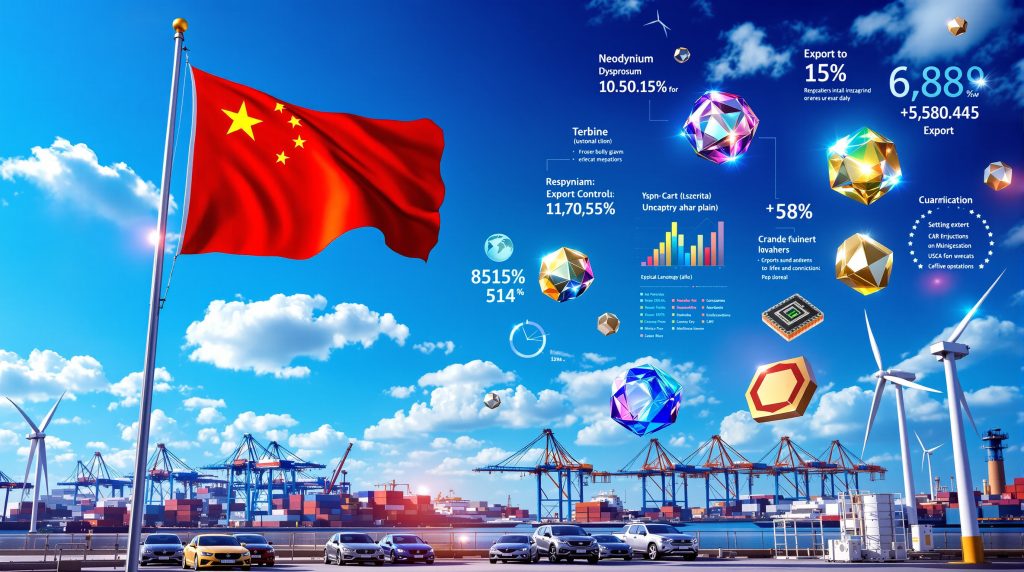The intersection of geopolitics and critical materials has reached unprecedented complexity as China's strategic approach to rare earth management continues evolving. The nation's sophisticated regulatory framework operates through detailed China antimony controls and related mechanisms that distinguish between different materials, processing stages, and end-use applications. This strategic governance model influences industries spanning renewable energy manufacturing to advanced defense technologies, creating cascading effects throughout international markets and highlighting the broader implications of critical minerals energy security.
The current policy architecture reflects decades of evolution from simple quota-based systems to highly nuanced licence-driven controls. Unlike earlier approaches that imposed blanket restrictions, today's framework enables selective application of controls based on strategic priorities and geopolitical considerations. This shift represents a fundamental change in how critical materials governance operates in the global economy.
Export Control Implementation Through MOFCOM Announcements
The Documentary Architecture of Restrictions
China's export control mechanisms function through specific Ministry of Commerce (MOFCOM) announcements that create legally binding requirements for different categories of materials and technologies. According to recent analysis, the system operates through distinct regulatory instruments rather than unified policy documents.
The framework distinguishes between three primary categories:
• Dual-use technology controls governing materials with potential military applications
• Rare earth element restrictions targeting specific oxides and separation technologies
• Strategic material controls with sector-specific carve-outs and end-user prohibitions
Regulatory Instrument Specificity
The control mechanisms require understanding at the individual announcement level. MOFCOM Announcement No. 18, implemented in April 2025, established export restrictions on rare earth oxides and separation technologies specifically tied to neodymium-iron-boron (NdFeB) magnet production. Meanwhile, MOFCOM Announcement No. 70 addresses dual-use controls with different scope and duration parameters.
This announcement-based approach provides China with significant operational flexibility, enabling targeted adjustments without comprehensive policy overhauls. Each instrument specifies affected materials, implementation duration, and sectoral exceptions, creating a complex compliance environment for international manufacturers.
Timeline of 2025 Policy Transformations
April 2025 Foundation Restrictions
The initial wave of China rare earth export controls established restrictions on seven critical rare earth elements through MOFCOM Announcement No. 18. These controls specifically target rare earth oxides and NdFeB magnet materials, components essential for electric vehicle motors, wind turbine generators, and various precision industrial applications.
The April implementation marked a strategic shift toward material-specific controls rather than broad sectoral restrictions. This approach enables more precise targeting of industries deemed strategically significant whilst maintaining general commercial access for less sensitive applications.
October 2025 Expansion and November Suspension
October 2025 witnessed the introduction of additional measures, including provisions extending Chinese regulatory jurisdiction to products manufactured outside China using Chinese-origin materials or technologies. However, these October measures were subsequently suspended through MOFCOM Announcement No. 70, effective until November 2026.
Furthermore, analysis reveals a critical distinction often overlooked in political commentary: only the October 2025 export control announcements have been paused. The earlier and more consequential April 2025 controls remain fully operational, creating a policy bifurcation with significant implications for supply chain planning.
| Policy Phase | Implementation Date | Status as of November 2025 | Key Materials Affected |
|---|---|---|---|
| Initial Controls | April 2025 | Fully Active | Rare earth oxides, NdFeB materials |
| Extended Measures | October 2025 | Suspended until Nov 2026 | Dual-use technologies |
| Sectoral Adjustments | November 2025 | Selective easing | Graphite, gallium (military restrictions maintained) |
Industrial Sector Vulnerability Assessment
Permanent Magnet Manufacturing Dependencies
Industries requiring NdFeB magnets face the most direct exposure to China rare earth export controls. These high-performance permanent magnets are essential components in:
• Electric vehicle drive motors requiring precise torque control
• Direct-drive wind turbine generators operating in harsh environmental conditions
• Precision manufacturing equipment demanding consistent magnetic field strength
• Advanced medical imaging systems requiring specialised magnetic properties
The restriction on materials tied to NdFeB magnet production creates immediate supply chain concerns for manufacturers operating just-in-time production systems. Alternative magnet technologies exist but typically involve performance trade-offs or significantly higher costs.
Clean Energy Infrastructure Implications
The renewable energy sector faces compound vulnerabilities through rare earth dependencies in multiple system components. Solar panel production requires specific rare earth compounds for photovoltaic efficiency enhancement, whilst grid-scale energy storage systems depend on rare earth materials for power conversion and battery management technologies.
Wind energy infrastructure presents particular challenges due to the dual dependency on both permanent magnets for generators and rare earth elements for power electronics systems. The concentration of these dependencies in Chinese supply chains creates systemic risks for renewable energy deployment targets across Western economies.
Defence and Aerospace Vulnerabilities
Military applications require rare earth elements with specialised performance characteristics often unavailable from alternative suppliers. MOFCOM Announcement No. 72 specifically maintains prohibitions on exports to U.S. military end-users for graphite and gallium, even whilst softening certain civilian restrictions.
Critical defence applications include:
• Precision-guided munitions requiring miniaturised magnetic guidance systems
• Advanced radar installations dependent on rare earth-enhanced electronic components
• Satellite communication systems utilising specialised optical amplification technologies
• Electronic warfare capabilities requiring radiation-hardened rare earth compounds
These dependencies underscore the importance of comprehensive defense materials strategy development to address supply chain vulnerabilities.
Historical Context and Policy Evolution
Comparison with Previous Trade Interventions
China's current approach represents a significant evolution from earlier export control strategies. The 2010-2012 period featured export quotas and tariffs that prompted World Trade Organization disputes filed by the United States, European Union, and Japan. The WTO Appellate Body ultimately ruled against China in 2014, finding that export quotas on rare earth elements violated international trade obligations.
The 2015-2020 period saw a transition toward market-based pricing mechanisms, with supply allocation determined primarily through commercial relationships rather than government quotas. This approach reduced international legal challenges whilst maintaining Chinese influence over global rare earth markets through processing capacity concentration.
Strategic Timing Analysis
The implementation of licence-based controls in 2025 coincides with accelerated global transitions toward renewable energy infrastructure and electric vehicle adoption. This timing maximises potential strategic leverage during critical supply chain development phases, when alternative sourcing options remain limited and expensive.
The evolution from quantity-limiting quotas to allocation-controlling licences provides China with enhanced flexibility to adjust restrictions based on geopolitical considerations without triggering automatic trade dispute mechanisms. This approach demonstrates strategic learning from earlier WTO challenges and reflects broader trends in mining industry evolution.
Geopolitical Implications and Security Considerations
Supply Chain Concentration Risks
Western economies maintain significant dependencies on Chinese rare earth processing capabilities, with limited short-term alternatives for critical manufacturing inputs. This concentration creates vulnerabilities extending beyond individual companies to encompass entire industrial sectors essential for economic competitiveness and national security.
The challenge extends beyond raw material access to encompass processing expertise, specialised equipment, and technical knowledge accumulated over decades of Chinese industry development. Replicating this infrastructure requires substantial capital investment and extended development timelines.
Defence Industrial Base Vulnerabilities
Military equipment manufacturers face particular exposure due to specialised performance requirements often unavailable through alternative suppliers. The maintenance of military end-user prohibitions, even during partial policy suspensions, demonstrates the strategic nature of these controls rather than purely commercial motivations.
Key defence vulnerabilities include:
• Weapons system dependencies: Advanced munitions requiring rare earth-enhanced guidance and propulsion systems
• Communication infrastructure: Secure military communications dependent on rare earth-doped fibre optic systems
• Sensor technologies: Radar and electronic warfare systems utilising specialised rare earth compounds
• Space assets: Satellite systems requiring radiation-resistant rare earth materials for harsh operating environments
Global Market Response Strategies
Geographic Diversification Initiatives
International manufacturers are implementing comprehensive supply chain diversification strategies despite higher costs and extended development timelines. Key initiatives include:
Australian Production Expansion:
• Mountain Pass rare earth facility resumption and expansion
• Lynas Corporation processing capacity increases in Malaysia and Texas
• Critical Materials Corporation development projects
North American Capacity Development:
• MP Materials domestic processing infrastructure investment
• Canadian rare earth exploration and development projects
• Mexico strategic materials processing partnerships
African Mining Operations:
• Strategic partnerships with rare earth deposits in Madagascar, South Africa, and Tanzania
• Technology transfer agreements for processing capability development
• Infrastructure investment in transportation and power systems
Technological Innovation Responses
Industries are pursuing multiple approaches to reduce rare earth dependencies:
• Material substitution research for applications where performance trade-offs are acceptable
• Efficiency improvements reducing total rare earth requirements per unit of production
• Recycling technology development enabling recovery from end-of-life products
• Alternative manufacturing processes requiring different material inputs
Analysing the November 2025 Suspension
Scope of Temporary Relief
The November 2025 suspension covers specific dual-use technology controls implemented in October whilst maintaining restrictions on rare earth oxides and NdFeB magnet materials from April. This selective approach creates a complex compliance environment requiring careful analysis of which materials and applications remain restricted.
Analysis emphasises that this represents partial easing rather than comprehensive détente. The suspension of MOFCOM Announcement No. 70 through November 2026 provides temporary relief for certain dual-use technologies, including synthetic diamonds and lithium-ion battery components, whilst core rare earth restrictions remain operative.
Policy Bifurcation Implications
The distinction between suspended and maintained restrictions creates strategic uncertainty for manufacturers planning sourcing strategies through 2026. Companies must navigate different regulatory frameworks for different materials, potentially requiring multiple compliance systems and supplier relationships.
The temporary suspension suggests tactical policy adjustment rather than strategic reversal, maintaining long-term leverage whilst providing short-term diplomatic flexibility during a sensitive geopolitical period. This approach demonstrates sophisticated strategic thinking similar to developments in China steel market insights.
Corporate Preparation Strategies
Supply Chain Risk Assessment
Companies dependent on Chinese rare earth supplies must implement comprehensive risk management frameworks addressing both current restrictions and potential future policy changes. Essential elements include:
Dependency Mapping:
• Complete auditing of rare earth content across all product lines
• Identification of single-source supplier vulnerabilities
• Assessment of inventory buffer adequacy for supply disruptions
• Evaluation of customer impact from potential shortages
Alternative Sourcing Development:
• Establishment of relationships with non-Chinese suppliers
• Investment in supply chain diversification despite higher costs
• Long-term purchase agreements to secure alternative capacity
• Participation in consortium purchasing arrangements
Compliance Infrastructure Requirements
Navigating China rare earth export controls requires sophisticated legal and operational capabilities:
• Regulatory expertise in export control law across multiple jurisdictions
• Documentation systems for material provenance and end-use certification
• Regular monitoring of policy announcements and regulatory changes
• Scenario planning for various restriction and suspension combinations
Companies must balance operational continuity requirements with long-term supply chain resilience, often requiring significant capital allocation to alternative sourcing arrangements with uncertain return timelines.
Long-Term Implications for International Trade
Precedent Setting for Resource Diplomacy
China's sophisticated approach to export controls may influence other resource-rich nations to implement similar strategic restrictions on critical materials. This could lead to further fragmentation of global supply chains across multiple commodities beyond rare earths.
The announcement-based policy implementation provides a model for maintaining strategic flexibility whilst avoiding automatic trade dispute triggers. Other nations may adopt similar approaches for lithium, cobalt, graphite, and other materials essential for clean energy transitions.
Technology Transfer Restrictions Evolution
The extension of Chinese regulatory jurisdiction to products manufactured outside China using Chinese-origin materials represents a significant expansion of extraterritorial control mechanisms. While currently suspended, this approach demonstrates policy tools available for future implementation.
This extraterritorial application mirrors approaches previously associated with U.S. semiconductor export controls, suggesting policy convergence in strategic technology governance between major powers.
Economic Bloc Formation Acceleration
Export control policies may accelerate the development of trading relationships based on strategic alignment rather than purely economic efficiency. This could lead to the formation of supply chain blocs with reduced interdependence between strategic competitors.
Such developments would fundamentally alter global trade patterns, potentially reducing overall economic efficiency whilst increasing supply chain resilience for participating nations.
Risk Management in a Complex Policy Environment
Understanding Narrative vs. Implementation Risks
Narrative risk has become as significant as supply risk in rare earth markets. Political statements and media coverage may not accurately reflect the actual scope and duration of policy changes, creating potential for strategic miscalculation.
Companies must develop capabilities to analyse source documents rather than relying solely on public commentary. The distinction between political characterisations and actual MOFCOM announcements illustrates the importance of direct regulatory analysis.
Strategic Planning Under Uncertainty
The temporary nature of current suspensions creates planning challenges requiring scenario-based approaches rather than single-point forecasts. Companies must prepare for multiple potential outcomes:
Scenario 1: Full Suspension Renewal
• Continued suspension of October measures through 2027
• Maintenance of April restrictions on core rare earth materials
• Gradual normalisation of supply chains with persistent vulnerabilities
Scenario 2: Partial Reinstatement
• Selective reimplementation of suspended measures based on geopolitical developments
• Continued uncertainty requiring flexible supply chain strategies
• Potential for additional material categories to face restrictions
Scenario 3: Comprehensive Restrictions
• Reimplementation of all suspended measures with potential expansion
• Acceleration of alternative supply chain development
• Significant cost increases for affected industries
Investment Decision Framework
Long-term capital allocation decisions require balancing immediate operational needs with strategic supply chain independence objectives. Key considerations include:
• Time horizon: Alternative supply development requires 5-10 year investment cycles
• Cost premiums: Non-Chinese sources typically involve 20-50% cost increases
• Performance trade-offs: Alternative materials may require design modifications
• Regulatory compliance: Multiple jurisdiction requirements increase operational complexity
Frequently Asked Questions About Export Control Navigation
Which rare earth elements face the most severe restrictions under current policies?
Heavy rare earth elements used in NdFeB magnet production, including dysprosium and terbium, face the most direct restrictions through MOFCOM Announcement No. 18, which remains fully operational despite other policy suspensions.
How long do companies typically need to establish alternative rare earth supply chains?
Complete supply chain diversification typically requires 3-7 years, depending on the specific elements, processing requirements, and performance specifications. Processing capacity development represents the longest lead-time component.
Do the current suspensions affect all international customers equally?
No, restrictions maintain specific carve-outs for military end-users and certain jurisdictions. MOFCOM Announcement No. 72 specifically maintains prohibitions on exports to U.S. military end-users even whilst easing certain civilian restrictions.
What documentation requirements exist for companies seeking rare earth imports?
Import procedures require detailed end-use certification, supply chain documentation, and compliance with both Chinese export licensing and destination country import requirements. Documentation requirements vary significantly based on specific materials and applications.
How do companies verify compliance with multiple overlapping restrictions?
Compliance requires legal expertise spanning multiple jurisdictions, regular monitoring of policy announcements, and systematic documentation of material sourcing and end-use applications. Many companies employ specialised compliance consultants or establish internal expertise.
Navigating Strategic Materials Governance in a Multipolar World
China rare earth export controls represent a fundamental transformation in how strategic materials governance operates within the global economy. The sophisticated policy architecture, operating through specific MOFCOM announcements rather than unified restrictions, creates both challenges and opportunities for international manufacturers.
The November 2025 suspension provides temporary relief for certain dual-use technologies whilst maintaining core restrictions on rare earth oxides and NdFeB magnet materials. This policy bifurcation requires companies to develop nuanced compliance strategies rather than assuming comprehensive policy reversals.
The broader implications extend beyond immediate supply chain adjustments to encompass questions of economic security, technological sovereignty, and the future structure of international trade in strategic materials. The concentration of rare earth processing capabilities in China creates systemic vulnerabilities that cannot be addressed through short-term policy adjustments alone.
Success in this environment requires companies to balance operational continuity with long-term supply chain resilience, often involving significant capital investment in alternative sourcing arrangements with uncertain timelines and higher costs. The development of non-Chinese processing capacity represents a strategic imperative for industries dependent on rare earth materials, despite the substantial financial and technical challenges involved.
The evolution of export control policies demonstrates the intersection of commercial supply chains with geopolitical strategy, requiring businesses to develop capabilities spanning technical, legal, and strategic analysis. As detailed examination of policy documents illustrates, understanding the details of regulatory implementation proves as important as monitoring high-level political rhetoric.
The path forward involves accepting higher costs and complexity in exchange for supply chain resilience and strategic independence. This transformation reflects broader shifts in the global economy toward supply chain regionalisation and strategic material security, trends likely to accelerate regardless of specific policy suspensions or modifications.
However, recent diplomatic developments suggest potential for managed relations despite underlying strategic competition.
Disclaimer: This analysis is based on publicly available information and policy documents as of November 2025. Export control policies can change rapidly based on geopolitical developments. Companies should consult with legal experts specialising in international trade law and maintain direct monitoring of official regulatory announcements for the most current information affecting their specific operations.
Are You Seeking Strategic Advantage in Critical Materials Markets?
Discovery Alert's proprietary Discovery IQ model provides real-time alerts on significant ASX mineral discoveries, particularly relevant as geopolitical tensions reshape global supply chains for critical materials like rare earths, antimony, and other strategic commodities. With historic discoveries demonstrating exceptional returns potential, subscribers gain immediate market insights to capitalise on emerging opportunities ahead of broader market recognition.




